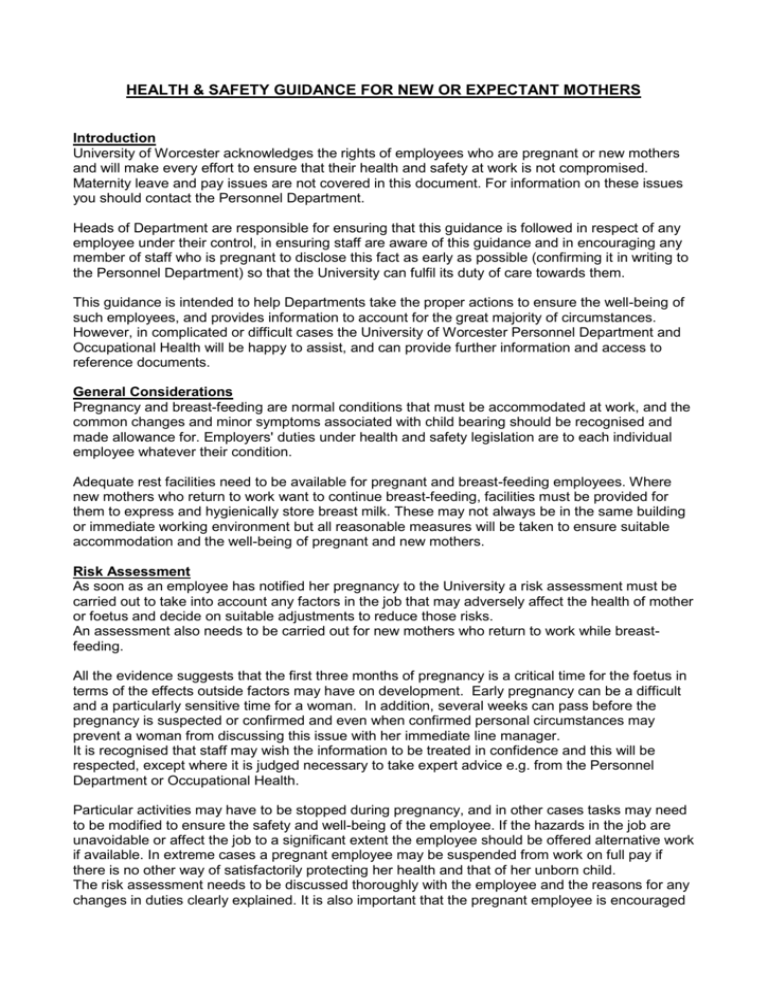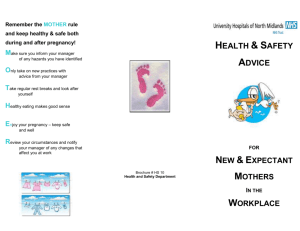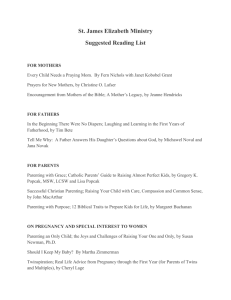Health and Safety Guidance
advertisement

HEALTH & SAFETY GUIDANCE FOR NEW OR EXPECTANT MOTHERS Introduction University of Worcester acknowledges the rights of employees who are pregnant or new mothers and will make every effort to ensure that their health and safety at work is not compromised. Maternity leave and pay issues are not covered in this document. For information on these issues you should contact the Personnel Department. Heads of Department are responsible for ensuring that this guidance is followed in respect of any employee under their control, in ensuring staff are aware of this guidance and in encouraging any member of staff who is pregnant to disclose this fact as early as possible (confirming it in writing to the Personnel Department) so that the University can fulfil its duty of care towards them. This guidance is intended to help Departments take the proper actions to ensure the well-being of such employees, and provides information to account for the great majority of circumstances. However, in complicated or difficult cases the University of Worcester Personnel Department and Occupational Health will be happy to assist, and can provide further information and access to reference documents. General Considerations Pregnancy and breast-feeding are normal conditions that must be accommodated at work, and the common changes and minor symptoms associated with child bearing should be recognised and made allowance for. Employers' duties under health and safety legislation are to each individual employee whatever their condition. Adequate rest facilities need to be available for pregnant and breast-feeding employees. Where new mothers who return to work want to continue breast-feeding, facilities must be provided for them to express and hygienically store breast milk. These may not always be in the same building or immediate working environment but all reasonable measures will be taken to ensure suitable accommodation and the well-being of pregnant and new mothers. Risk Assessment As soon as an employee has notified her pregnancy to the University a risk assessment must be carried out to take into account any factors in the job that may adversely affect the health of mother or foetus and decide on suitable adjustments to reduce those risks. An assessment also needs to be carried out for new mothers who return to work while breastfeeding. All the evidence suggests that the first three months of pregnancy is a critical time for the foetus in terms of the effects outside factors may have on development. Early pregnancy can be a difficult and a particularly sensitive time for a woman. In addition, several weeks can pass before the pregnancy is suspected or confirmed and even when confirmed personal circumstances may prevent a woman from discussing this issue with her immediate line manager. It is recognised that staff may wish the information to be treated in confidence and this will be respected, except where it is judged necessary to take expert advice e.g. from the Personnel Department or Occupational Health. Particular activities may have to be stopped during pregnancy, and in other cases tasks may need to be modified to ensure the safety and well-being of the employee. If the hazards in the job are unavoidable or affect the job to a significant extent the employee should be offered alternative work if available. In extreme cases a pregnant employee may be suspended from work on full pay if there is no other way of satisfactorily protecting her health and that of her unborn child. The risk assessment needs to be discussed thoroughly with the employee and the reasons for any changes in duties clearly explained. It is also important that the pregnant employee is encouraged to ask about any aspects of work that worry them and be given reassurance where appropriate that particular activities or concerns are not considered to cause a risk in pregnancy. The risk assessment needs to be reviewed at intervals during the pregnancy, these intervals being decided by the nature of the work and the opinion of the assessor and the employee. As guidance the risk assessment should be reviewed at least once before the employee starts maternity leave and may need to reviewed several times if the work changes or if the employee suffers any adverse symptoms sometimes met in pregnancy. The University of Worcester Occupational Health Service should be consulted if there are unusual or difficult issues. There is specific advice and some regulatory prohibitions for pregnant women being exposed to certain types of hazard (Lead, Ionising Radiation, Compressed Air etc.) however the most common risks are as follows: 1. Manual Handling Physical and postural changes during and after pregnancy render women more susceptible to strain injuries if carrying out heavy work. Manual handling activities they are required to undertake should be carefully limited to avoid the risk of injury. Changes in balance, agility, reach and coordination may also increase the risk of accidents if carrying loads or handling. 2. Working with Display Screen Equipment While the equipment itself is not thought to present any hazards in pregnancy, the types of job associated with DSE use often mean sedentary work with limited opportunities to get up and move around. Departments should ensure that there is sufficient space at the workstation for the comfort of the pregnant employee at all stages of her pregnancy, allow more frequent rest breaks and changes of activity, and provide any additional back supports or other items to make them comfortable at the workstation. Workstations may need to be adjusted for user comfort as abdominal size increases. 3. Working Conditions Prolonged standing at work during pregnancy increases fatigue and may increase the likelihood of varicose veins. Jobs should be adjusted to allow the work mainly to be done seated. Working at height may cause difficulties and should be avoided especially in the later stages of pregnancy when balance and posture are more affected. 4. Stress and violence at work Hormonal changes during pregnancy and breast feeding and concerns about the pregnancy can cause women to be more easily upset by minor stresses they would normally cope with. Care should be taken to limit job stresses as far as possible. Stress can lead to high blood pressure, which may occur in pregnancy anyway; therefore stress at work could physically adversely affect mother and baby. Jobs where the work includes dealing with the public and students in possibly difficult situations should be carefully reviewed. Employers are only expected to protect against infection risks arising from the work, not infections contracted casually from other staff. However, there may occasionally be reason, such as a significant flu outbreak, to consider staying off work for a while so as to protect the well-being of a pregnant employee. 5. Smoking Although the University of Worcester is a no smoking work environment pregnant employees should be advised of the risks. January 2006







